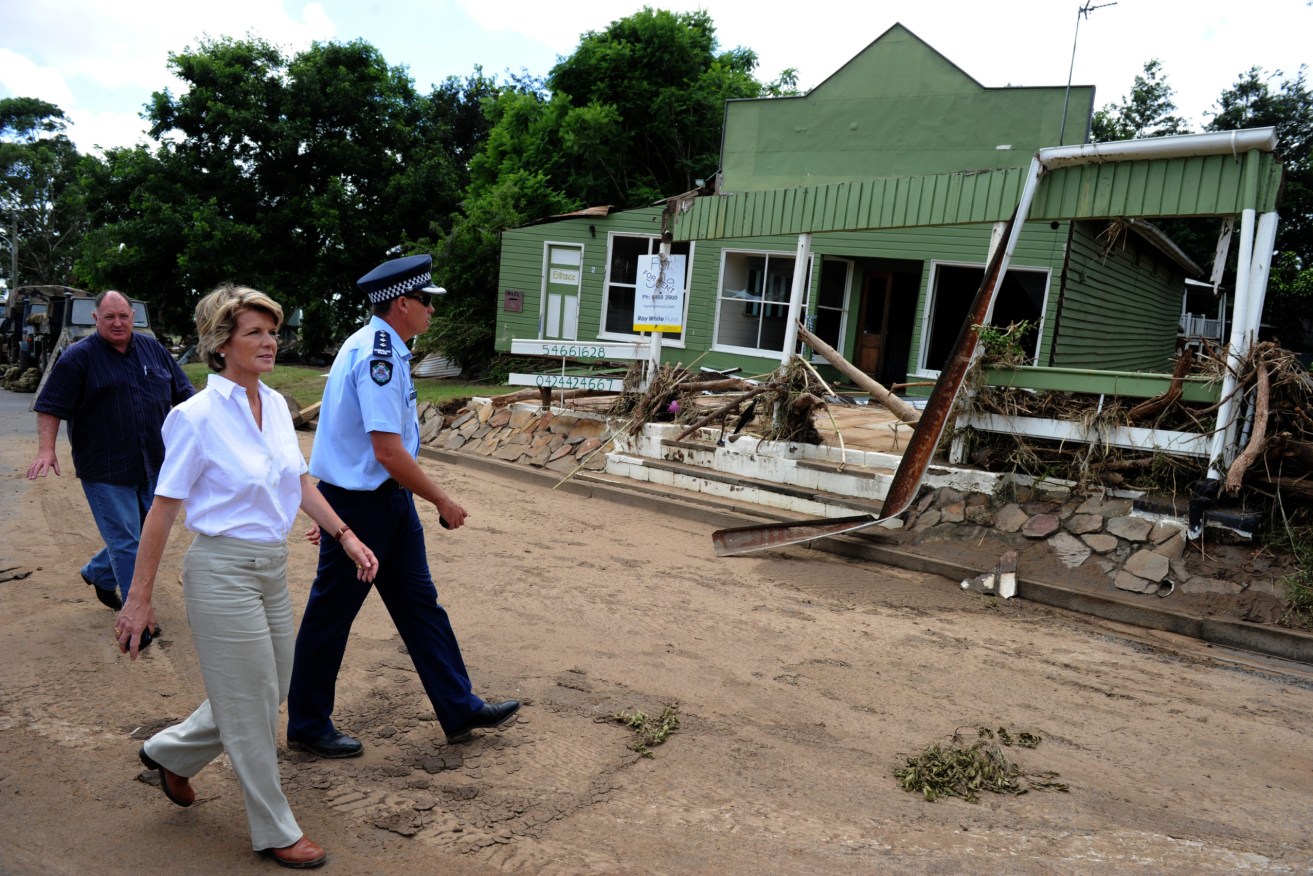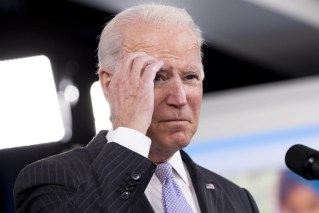When leadership moves mountains, or even an entire town
Real leaders step up and prove themselves during disasters, whether the emergency comes in the form of fires, floods or even a microscopic parasite that can wreak havoc in the lungs.


then-federal deputy opposition leader Julie Bishop tours the township of Grantham following the devastating floods that ripped through the Lockyer Valley in January 2011. (Photo: AAP Image/Dean Lewins)
Sadly, in an era where our attention flits like a swarm of digital gadflies from breaking news to #scandal to “You Won’t Believe What Happened Next” headlines, it is easy to forget the lessons those leaders can teach us, and the fine role models they represent.
Unless we pay attention, we are bound to repeat the same mistakes. We’re more likely to mistake spin for substance, and marketing for mettle in our leaders.
For example: remember the time a small band of rural Queenslanders rose to the challenge of moving an entire town?
Grantham, a rural hamlet of about 600 people, was ground zero when southeast Queensland was hit by massive floods in January, 2011. Twelve of the town’s residents died when an “inland tsunami”, as then-Police Commission Bob Atkinson described it, rolled across the Lockyer Valley. More than a hundred houses in the local area were destroyed or simply swept away, and roughly 1000 vehicles mangled, including valuable farm machinery. Livelihoods were ruined in a matter of minutes.
Soon afterwards, Lockyer Valley mayor Steve Jones decided Grantham residents couldn’t be expected to simply pick up their lives and rebuild amid the wreckage, especially if that meant accepting the awful ongoing risk of another wall of water sweeping down on them at any time.
He declared that the town of Grantham would be relocated to higher ground.
Imagine that. An entire town.
Imagine the complexities of simply preparing a site for residential purposes, with roads and electricity and all those other amenities. Then add the challenge of carrying a group of utterly traumatised folk along with you, so that this development was not actually an entirely new town, but one that retained the spirit and neighbourhood connections and proud history of an established community.
Now imagine doing all of that in less than a year.
That is exactly what Jones did, having promised the community they would be in their safe new community by Christmas 2011. When he delivered, the Grantham Relocation would be hailed as an Australian first, gaining international attention as a timely example of adaptation to the threats of extreme weather.
Sadly, Jones died suddenly in 2016. But his right-hand man, environmental engineer Jamie Simmonds, has recounted the remarkable feat, and the lessons learnt along the way, in his book Rising From The Flood.
With an eye to the massive bushfire recovery efforts that are in danger of disappearing from the public radar, I asked Simmonds to name five key lessons from the Grantham relocation:
1. Anyone can talk big in the aftermath of a disaster, but leaders are the ones who show up for the long road to recovery. “Look at any disaster and there’s always a few people – usually politicians – who will tell everyone that it’s all going to be OK,” Simmonds says. “But to keep everyone focused and engaged, there needs to be action, otherwise people can feel betrayed, or worse, begin to lose hope. In Grantham, we knew people were so heavily traumatised, if we made promises we not only had to keep them – we had to move as fast as we could to keep the momentum to bring them along with us.”
2. Those most in need are often last to speak up. “If you don’t realise this fact early on, you will be side-tracked by the whims of a loud minority,” Simmonds warns. “The real work in bringing all of the community along on the journey happens away from the big meetings. It happens around the barbecue, or on the street, or over a cup of tea in an old lady’s kitchen. The one-on-one discussions are the best and really the only way to get the real information out there and to understand the needs of the community.”
3. Not all help is equal. “People like to give to communities that suffer a disaster, and affected communities like to know that other people, even total strangers, care about them,” he says. “But the logistics of managing this can be as difficult as dealing with the disaster itself. In Grantham, we received well over 300 semitrailer loads of goods, and all of that had to be sorted, stored and distributed. Furthermore, it can ruin local businesses as nobody buys anything from them anymore. It can also split communities as some people try to get everything they can, and the people who don’t want to take anything are usually the people that really need the help. So we had to deal with a lot of turmoil in relation to donated goods and money.”
4. Local leadership is vital – and must be respected. “Even with the best intentions, bureaucrats and state and federal politicians are usually in a major city making decisions for a community that is a long way away, that many have never seen before,” Simmonds says. “The real issue is they don’t understand the needs of the community. They don’t have to look a family in the eyes every day and see their suffering. They don’t have a grown man crying on their shoulder, or a kid wondering where they are going to sleep tonight. So it’s easy to detach themselves from the reality.
“We were successful because Steve and I were in the community all the time, trying to sort out real problems for people that were truly devastated. We were ready to fight anyone that got in the way of the vision we had. Steve would tell them to come out to Grantham and slap the handcuffs on him because he’d be the first one to break the rules. In many ways, this ‘cowboy’ approach we had with state and federal agencies helped us, because the community could see we were fighting for them. And in the end, no one from outside was really game to stop us. Was some of it an act? Probably, but I think it worked well!”
5. Disaster fatigue is real. “I’ve heard Peter Cosgrove has been talking about ‘disaster fatigue’,” Simmonds says of the former governor-general and decorated general, now coordinating efforts by the business community to help repair bushfire-broken communities. “ That’s essentially when people forget about a disaster and move on to the next thing.
“In Grantham, we knew if we played the victim card, people would turn off. So we tried to turn the story from a suffering community to a community that gratefully accepted the generosity and used it to do something extraordinary. We wanted people to see that they gave us a hand when we needed it, but we stood up on our own.
“We would turn the disaster into a positive and make Grantham a better and safer place.”
You can learn more about the lessons of the Grantham relocation and order Rising From The Flood here.












